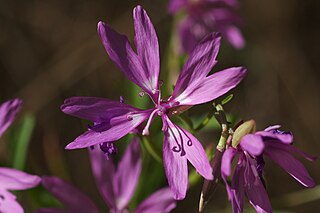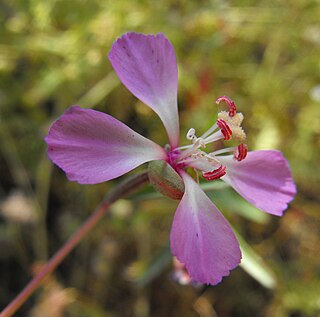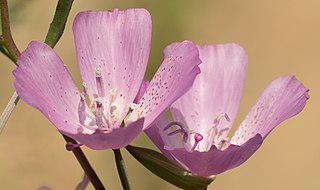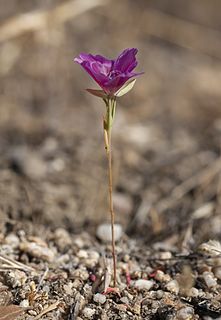
Clarkia breweri is a species of wildflower known by the common names fairy fans and Brewer's clarkia. This rare plant is endemic to California, where it is known from only seven counties in the central part of the state. It produces short stems under 20 centimeters in height and sparse, narrow leaves. The distinctive flowers have four pink to lavender petals, each about 2 centimeters long and wide, with 3 odd lobes, the middle lobe being long and spoon-shaped.

Clarkia gracilis is a species of wildflower known by the common name slender clarkia. This plant is native to the US states of California, Oregon, and Washington, where it is found in coastal, foothill, valley, and low-elevation mountain habitats. The plant is variable across subspecies but is generally an erect slender stem with a few sparse, narrow leaves several centimeters long. It bears an inflorescence of drooping buds which open into bowl-shaped flowers with pinkish lavender petals 1 to 4 centimeters long and bearing a red or white splotch which can appear in the center or at the base of the petal, depending on the subspecies.

Clarkia purpurea is a species of wildflower known by the common names winecup clarkia, winecup fairyfan, and purple clarkia.

Clarkia cylindrica is a species of flowering plant in the evening primrose family known by the common name speckled fairyfan, or speckled clarkia.

Clarkia arcuata is a species of flowering plant in the evening primrose family known by the common name glandular clarkia. It is endemic to California, where it grows in the chaparral and woodlands of the foothills of the Sierra Nevada and southern Cascade Range. It is an annual herb producing a slender, erect stem often exceeding half a meter in height. The leaves are narrow, usually linear or lance-shaped, and up to 6 centimeters long. The inflorescence bears a few flowers, which dangle when they are buds and grow erect as they open. The sepals stay fused as the petals open and emerge from one side. They are coated in glandular hairs. The petals are up to 3 centimeters long, pink-lavender in color, sometimes with a reddish blotch at the base. They form a bowl-shaped corolla. There are 8 stamens and a protruding, four-chambered ovary. The fruit is an elongated capsule which may reach 3.5 centimeters long.

Clarkia biloba is a species of flowering plant in the evening primrose family known by the common name twolobe clarkia and two lobed clarkia.

Clarkia delicata is a rare species of flowering plant in the evening primrose family known by the common names Campo clarkia and delicate clarkia. It is native to northern Baja California and adjacent San Diego County, California, where it grows in the woodland and chaparral of the Peninsular Ranges. This is an annual herb producing an erect stem just over half a meter in maximum height. The leaves are oval or widely lance-shaped, up to 4 centimeters long, and borne on very short petioles. The top of the stem is occupied by the inflorescence, in which the lower flowers open while the upper buds hang closed. The sepals remain fused as the flower blooms from one side. Each unlobed oval petal is about a centimeter long and pink to pinkish-lavender. There are 8 stamens, some with large orange anthers and some with smaller, paler anthers. There is also a protruding stigma with four large, fuzzy lobes.

Clarkia dudleyana is a species of flowering plant in the evening primrose family known by the common name Dudley's clarkia. It is endemic to California, where it can be found in the mountains of the Transverse Ranges and the southern Sierra Nevada foothills. It grows in woodland, forest, and chaparral habitats under 1500 meters in elevation. This annual herb produces an erect stem sometimes exceeding half a meter in height. The leaves are lance-shaped, up to 7 centimeters long, and borne on short petioles. The top of the stem is occupied by the inflorescence, which has opening flowers below closed, hanging buds. As the flower blooms the pink to reddish-purple sepals remain fused, opening along one side only. The petals are up to 3 centimeters long, fan-shaped, pinkish lavender in color and sometimes flecked with red. There are 8 stamens, some of which have large lavender anthers and some that have smaller, paler anthers. The stigma protrudes farther than the stamens.

Clarkia exilis is a small herbaceous annual plant of western North America. It is an uncommon species in the evening primrose family known by the common names Kern River clarkia and slender clarkia.

Clarkia franciscana is a rare species of flowering plant in the evening primrose family known by the common name Presidio clarkia. It is endemic to the San Francisco Bay Area of California, where it is known only from two populations at the Presidio of San Francisco and three occurrences in Oakland. The plant is known only from serpentine soils.
Clarkia heterandra is a species of flowering plant in the evening primrose family known by the common name mountain clarkia. It is endemic to California, where it is from the forests and woodlands of several of eastern and western mountain ranges. It is an annual herb producing an erect, glandular stem to around half a meter in maximum height. The lance-shaped to oval leaves are up to 8 centimeters long and are borne on petioles of up to 2 centimeters. The top of the stem is occupied by the inflorescence, with open flowers and closed buds. The sepals remain fused as the flower blooms from one side. The pink petals are oval in shape and just a few millimeters long. There are 8 stamens, some large and some small and sterile. The fruit is a small, hard body 2 or 3 millimeters long containing 1 or 2 seeds.

Clarkia imbricata is a rare species of flowering plant in the evening primrose family known by the common name Vine Hill clarkia. It is endemic to Sonoma County, California, where it is known from only one remaining natural occurrence near Vine Hill. A second natural population located on private land was extirpated when the owners plowed up the soil crust. The California Native Plant Society has established a third population from cuttings and is tending it in a reserve. This is a federally listed endangered species.

Clarkia jolonensis is an uncommon species of flowering plant in the evening primrose family known by the common name Jolon clarkia. It is endemic to Monterey County, California, where it is known from the woodlands of the Central Coast Ranges.
Clarkia lewisii is an uncommon species of flowering plant in the evening primrose family known by the common name Lewis' clarkia. It is endemic to California, where it is known from the hills and mountains of Monterey and San Benito Counties. It is an erect annual herb generally under half a meter in height. The lance-shaped leaves are a few centimeters long. The inflorescence bears opening flowers and closed, hanging flower buds. As the bud opens the pink or purple sepals stay fused as the petals bloom from one side. The fan-shaped petals are up to 3 centimeters long, pink to lavender with white and red coloration near the bases. There are 8 stamens and a protruding stigma.

Clarkia mosquinii is a rare species of flowering plant in the evening primrose family known by the common name Mosquin's clarkia. It is endemic to California, where it is known only from the northern Sierra Nevada foothills at the border between Butte and Plumas Counties. It was thought to be extinct until it was rediscovered in 1991. It is an erect annual herb often exceeding half a meter in height. The oval or lance-shaped leaves are 2 to 5 centimeters long. The inflorescence bears opening flowers below a series of clusters of closed, hanging flower buds. The sepals all separate as the flower blooms. The diamond-shaped petals are one to two centimeters long light to medium purple in color, and sometimes speckled with reddish purple.

Clarkia springvillensis is a rare species of flowering plant in the evening primrose family known by the common name Springville clarkia. It is endemic to central Tulare County, California, where it is known from fewer than 20 occurrences around Springville. It is a federally listed threatened species.
Clarkia tembloriensis is a rare species of flowering plant in the evening primrose family, known by the common name Temblor Range clarkia and belonging to the Onagraceae family.

Clarkia virgata is a species of flowering plant in the evening primrose family known by the common name Sierra clarkia. It is endemic to California, where it is known from the forests and woodlands of the Sierra Nevada.

Clarkia williamsonii is a species of flowering plant endemic to California, where it is known from the forests and woodlands of the northern and central Sierra Nevada foothills.

Clarkia xantiana is a species of flowering plant in the evening primrose family known by the common name gunsight clarkia. It is endemic to California, where it is known from the southern Sierra Nevada and its foothills and the adjacent Transverse Ranges. This is an erect annual herb with linear to lance-shaped leaves each up to 6 centimeters long. The inflorescence produces opening flowers and closed buds. The sepals stay fused as the petals bloom from one side. Each petal is up to 2 centimeters long and generally light to medium purple in color, sometimes with a dark, ringed spot on the petals of the upper whorl. The petal has a narrow claw and a wider blade which has two lobes at the tip with a small tooth between.

















